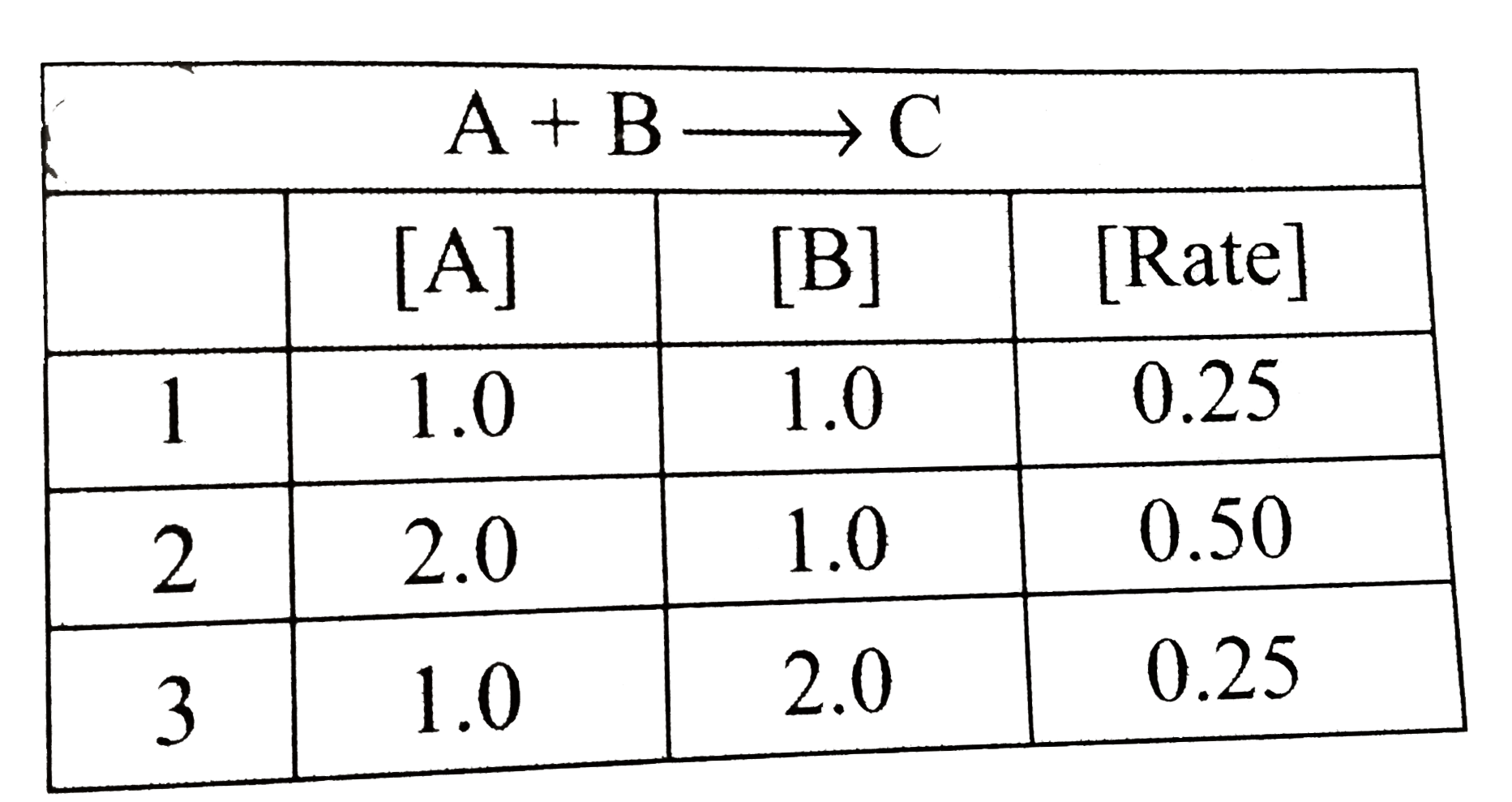Hydrolyiss of an alkyl halide (RX) by dilute alkali [OH]ɵ takes place ismultaneously by SN2 and SN1 pathways. A plot of −1[RX]d[R−X]dt vs [OH]ɵ is a straight line of the slope equal to 2×103mol−1Lh−1 and intercept equal to 1×102h−1. Calculate the initial rate (moleL−1−1min) of consumption of RX when the reaction is carried out taking molL−1 of RX and 0.1molL−1 of [OH]ɵ ions.
The correct Answer is:5
To solve the problem, we need to calculate the initial rate of consumption of the alkyl halide RX when the concentrations of RX and OH− ions are given. The reaction proceeds via both SN2 and SN1 pathways.
1. Write the Rate Expressions:
- For the SN2 pathway:
RateSN2=k2(RX)(OH−)
- For the SN1 pathway:
RateSN1=k1(RX)
2. Combine the Rate Expressions:
The overall rate of consumption of RX can be expressed as:
−d(R−X)dt=k2(RX)(OH−)+k1(RX)
This can be factored as:
−d(R−X)dt=(RX)(k2(OH−)+k1)
3. Divide by (RX):
To express the rate in terms of 1(RX):
−1(RX)d(R−X)dt=k2(OH−)+k1
4. Identify the Slope and Intercept:
From the problem statement, we know:
- Slope m=2×103mol−1Lh−1
- Intercept c=1×102h−1
Therefore, we can write:
−1(RX)d(R−X)dt=2×103(OH−)+1×102
5. Substitute the Known Concentrations:
Given:
- (RX)=1.0mol L−1
- (OH−)=0.1mol L−1
Substitute these values into the equation:
−11.0d(R−X)dt=2×103×0.1+1×102
6. Calculate the Rate:
−d(R−X)dt=2×103×0.1+1×102
−d(R−X)dt=200+100=300mol L−1h−1
7. Convert to Minutes:
Since the question asks for the rate in mol L−1min−1:
−d(R−X)dt=300mol L−1h−160min h−1=5mol L−1min−1
Final Answer:
The initial rate of consumption of RX is 5mol L−1min−1.
- For the SN2 pathway:
RateSN2=k2(RX)(OH−)
- For the SN1 pathway:
RateSN1=k1(RX)
The overall rate of consumption of RX can be expressed as:
−d(R−X)dt=k2(RX)(OH−)+k1(RX)
This can be factored as:
−d(R−X)dt=(RX)(k2(OH−)+k1)
To express the rate in terms of 1(RX):
−1(RX)d(R−X)dt=k2(OH−)+k1
From the problem statement, we know:
- Slope m=2×103mol−1Lh−1
- Intercept c=1×102h−1
−1(RX)d(R−X)dt=2×103(OH−)+1×102
Given:
- (RX)=1.0mol L−1
- (OH−)=0.1mol L−1
−11.0d(R−X)dt=2×103×0.1+1×102
−d(R−X)dt=2×103×0.1+1×102
−d(R−X)dt=200+100=300mol L−1h−1
Since the question asks for the rate in mol L−1min−1:
−d(R−X)dt=300mol L−1h−160min h−1=5mol L−1min−1
The initial rate of consumption of RX is 5mol L−1min−1.
Topper's Solved these Questions
- CHEMICAL KINETICSBOOK - CENGAGE CHEMISTRY ENGLISHCHAPTER - CHEMICAL KINETICSEXERCISE - Exercises Fill In The Blanks
37 Videos
- CHEMICAL KINETICSBOOK - CENGAGE CHEMISTRY ENGLISHCHAPTER - CHEMICAL KINETICSEXERCISE - Exercises True/False
29 Videos
- CHEMICAL KINETICSBOOK - CENGAGE CHEMISTRY ENGLISHCHAPTER - CHEMICAL KINETICSEXERCISE - Exercises Assertion-Reasoning
22 Videos
- CARBOXYLIC ACIDS AND THEIR DERIVATIVESBOOK - CENGAGE CHEMISTRY ENGLISHCHAPTER - CARBOXYLIC ACIDS AND THEIR DERIVATIVESEXERCISE - Exercises Archives (Analytical And Descriptive)
34 Videos
- COORDINATION COMPOUNDSBOOK - CENGAGE CHEMISTRY ENGLISHCHAPTER - COORDINATION COMPOUNDSEXERCISE - Archives Subjective
18 Videos
Similar Questions
Rate constant k=1.2×103mol−1Ls−1 and Ea=2.0×102kJmol−1. When T→∞:
View SolutionA secondary alkyl halide (A) hydrolyzes with alkali (B) in aqueous medium ismultaneously via SN1 and SN2 pathways with rate constants k1 and k2, respectively. form kinetic data, it was found that a plot of =−1[A]d[A]dt vs [B] is straight line with a slope equal to 2.7×10−4Lmol−1−1min and intercept equal to 1.02×10−3. Minimum initial concentration of [A]=0.2M and [B], i.e., [ɵOH]=0.5M.
The initial rate of consumption is isopropyl chloride (in M−1min) is
(a)0.2×10−3
(b)3×10−5
(c)2.31×10−4
(d)2.31×10−3
View Solution
Rate is expressed in molL−1−1min.
In the above reaction, the order is
View SolutionA secondary alkyl halide (A) hydrolyzes with alkali (B) in aqueous medium ismultaneously via SN1 and SN2 pathways with rate constants k1 and k2, respectively. form kinetic data, it was found that a plot of =−1[A]d[A]dt vs [B] is straight line with a slope equal to 2.7×10−4Lmol−1−1min and intercept equal to 1.02×10−3. Minimum initial concentration of [A]=0.2M and [B], i.e., [ɵOH]=0.5M.
The value of overall rate constant of the hydrolyiss of A (in Lmol−1−1min) is
View SolutionThe rate first order reaction is 2.4×10−3molL−1s−1, when the initial concentration is 0.2molL−1. The rate constant is…………. .
View SolutionThe rate for the 1st order reaction is 0.69×10−2molL−1−1min and the initial concentration is 0.2 mol L−1 . The half life period is ____.
View SolutionIdentify the reaction order from each of the following rate :
k=2.3×105Lmol−1s−1
View SolutionIdentify the reaction order from each of the following rate :
k=2.3×105Lmol−1s−1
View SolutionIdentify the reaction order from each of the following rate :
k=2.3×105Lmol−1s−1
View SolutionThe rate of a second order reaction is 6×10−5molL−1s−1, when the initial concentration is 0.2molL−1. The rate constant is………………… .
View Solution